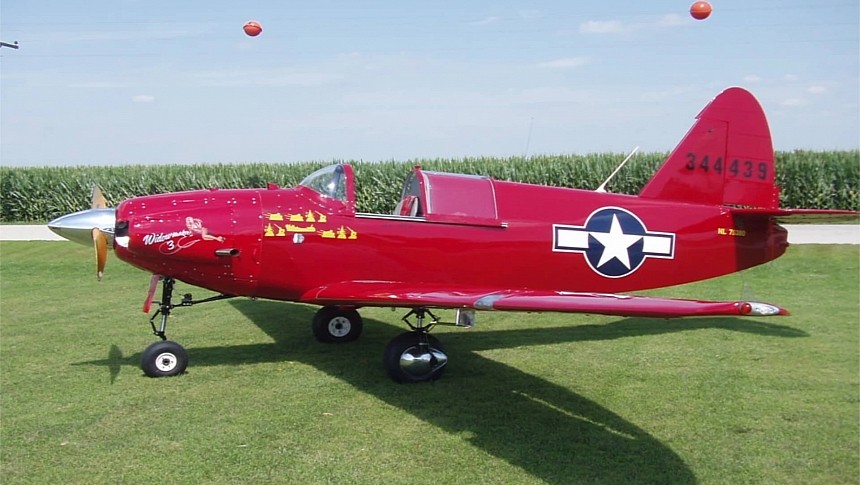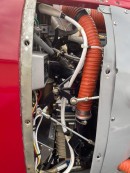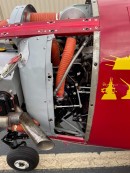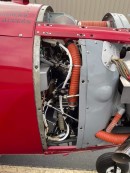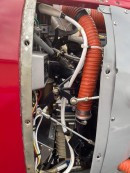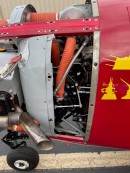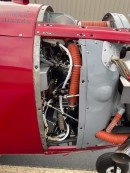A short while ago, we told the story of the Culver PQ-14 Cadet, a long-forgotten Second World War target practice plane designed to be easy for a trainee pilot to empty their ammo mag into without feeling too badly about blowing up tax-payer dollars. The fact it was unmanned and flown via radio was another big help in that regard. In a perfect world, not a single PQ-14 makes it to the 21st century because they'd all served their purpose and been shot down as targets. But a handful did indeed survive the war.
What a relief, too, because when modern high-res cameras get a good exposure on this shiny little red sled, the results look like a Ferrari with wings. Funnily enough, a modern Ferrari Roma is probably faster at the top end than this thing. Derived itself from the Culver PQ-8 civilian plane, over 2,000 PQ-14s were built from 1942 to 1945. Today, it's thought only around eight still survive, of which this one for sale via Platinum Fighter Sales of Redondo Beach, California, is a member.
With a Franklin 6ACT air-cooled, six-cylinder boxer engine under the hood, pilots who managed to acquire the few Culver Cadets not full of 20 mm cannon holes found its low-slung, low-wing layout made for an exciting airplane to fly. Indeed, it's probably because the PQ-14 was built to look and fly like a scaled-down enemy fighter, which makes it a spry, enjoyable plane to fly now. This particular example, a later PQ-14B model with a slightly heavier and more stable airframe, has been in the care of a Chenoia, Illinois man named Harry Pick since December 1992.
At that time, the plane received enough routine maintenance to keep its airframe in serviceable shape before it was towed into a hangar and fully restored in 2012. Its engine, propeller, and landing gear were all removed and inspected while its trademark red paint went in for touch-ups from nose to tail. With everything all put back together and fitted with modern GPS and communications hardware, this is the kind of private plane with a far more colorful story to tell than the Cessnas and Mooneys this Cadet shares airport space with. Funnily enough, the Cadet was designed by Al Mooney. Small world, right?
With only 75 hours in the air since its restoration and an award list that includes accolades at the prestigious EAA AirVenture Oshkosh event in 2012, only this plane's lack of wider public appeal keeps it from being a million-dollar airframe. But according to its web listing, this piece of Second World War aviation history can be all yours for just $60,000 before taxes and fees. So then, between a Culver Cadet and a mid-size BMW straight out of the dealership, we know which one we'd pick.
With a Franklin 6ACT air-cooled, six-cylinder boxer engine under the hood, pilots who managed to acquire the few Culver Cadets not full of 20 mm cannon holes found its low-slung, low-wing layout made for an exciting airplane to fly. Indeed, it's probably because the PQ-14 was built to look and fly like a scaled-down enemy fighter, which makes it a spry, enjoyable plane to fly now. This particular example, a later PQ-14B model with a slightly heavier and more stable airframe, has been in the care of a Chenoia, Illinois man named Harry Pick since December 1992.
At that time, the plane received enough routine maintenance to keep its airframe in serviceable shape before it was towed into a hangar and fully restored in 2012. Its engine, propeller, and landing gear were all removed and inspected while its trademark red paint went in for touch-ups from nose to tail. With everything all put back together and fitted with modern GPS and communications hardware, this is the kind of private plane with a far more colorful story to tell than the Cessnas and Mooneys this Cadet shares airport space with. Funnily enough, the Cadet was designed by Al Mooney. Small world, right?
With only 75 hours in the air since its restoration and an award list that includes accolades at the prestigious EAA AirVenture Oshkosh event in 2012, only this plane's lack of wider public appeal keeps it from being a million-dollar airframe. But according to its web listing, this piece of Second World War aviation history can be all yours for just $60,000 before taxes and fees. So then, between a Culver Cadet and a mid-size BMW straight out of the dealership, we know which one we'd pick.
